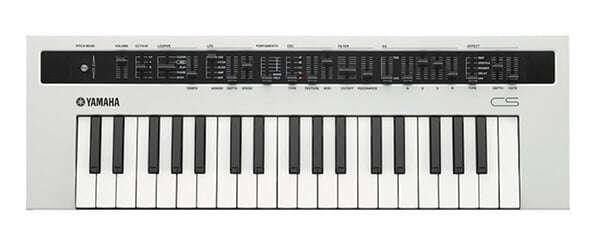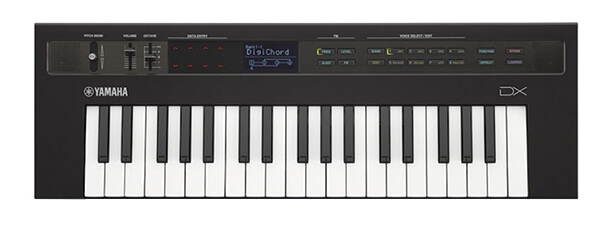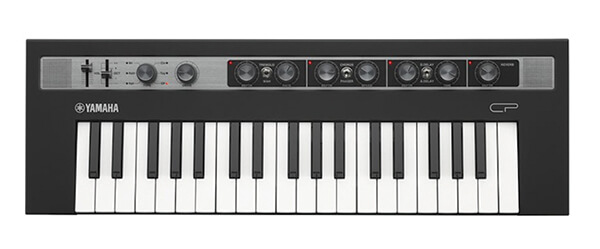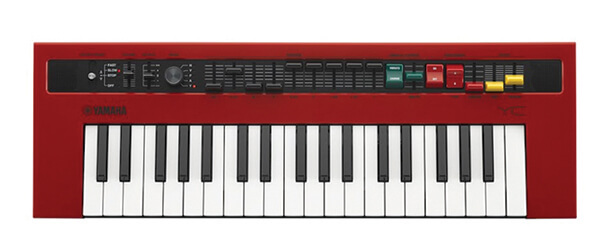YAMAHA Reface Series Keyboards
PROS: Fantastic design, functionality and sounds.
CONS: Mini keys may turn off some users, price is at the upper limit. (price has been reduced since our initial review was published)
PRICE: $499/each NOW $399/each
The new Reface synth series from Yamaha is a cool trip down memory lane, a series of 4 individual keyboards that each serve a specific function (and evoke a memory of a classic piece of hardware from yesteryear).
The throwback series has meet with two main criticisms from online loudmouths – notably the inclusion of mini-keys over full-sized keys, and the fact that the price is basically at the upper limit of what people would pay for such units. Let’s address both issues.
As far as mini-keys go, it’s a non-issue for us. We didn’t feel they were all that uncomfortable to play, much like the transition from a Fender scale length to a Gibson scale length in the guitar world. If you’re really hung up on it, I suppose you could use a full-sized board to control your Reface via MIDI, but it seems like a lot of work that ultimately isn’t necessary. As for the pricing, at $499 we agree that it’s about the max we’d pay for these portable units. Don’t get us wrong, having classic sounds (and tactile controls) on the boards is great, and we really ended up digging each one’s personality, but at $399 or even $429 these would be KILLER APPS. Now, we don’t work for Yamaha, so who knows if those price points are even feasible, we just call ’em how we see ’em. [EDITOR’S NOTE: since our review ran in print, it appears as though the keyboards have seen a $100 price reduction at all major retailers.]
Let’s dig into each unit on its own…
REFACE CS

The CS is a modern, portable take on the old CS-80, and this was probably our favorite of the bunch. We dug the vintage vibe, and the physical faders that allows for ultimate tweakability. Like all the Reface units, it’s got two built in speakers that aren’t half bad for practicing, and it can even run on batteries. The CS in particular has a few handy on-board fx, which we enjoyed quite a bit. But most of all, we envision the CS being used for cool pads, phunky bass lines and by manipulating the various oscillator types, you can really hone in on textures and spacy lead tones that can make this particular unit an indispensable tool in any producer’s arsenal.
REFACE DX

OK, maybe we lied. Some days, this was our favorite. You’re dealing with the classic tones of a 4-operator FM synth (did someone say DX7?) and a touch surface where you can edit and store patches with ease. We dug the fact that Yamaha built a classic FM synth unit that stands alone in its field. By reimagining the old school DX into a modern form factor, you’ve got THE sound of the ’80s, sure, but with a modern twist. Tapping and sliding parameters with your fingertips on the screen is ultra-cool and intuitive, and provides instant feedback to the sound you’re shaping. If your thing is bell-like tones, tinkly piano or spaced-out cosmic waves, this might be your new go-to board.
REFACE CP

The CP is gonna be where traditional pianists and keyboard players find a home. Less emphasis on synth, waves, and sound shaping, the CP has shades of the old CP80 electric grand and features a number of cool keyboard/piano modes that sound incredible. Seriously, we were excited to just sit down and play – yeah, we know tweaking is great, but sometimes you just want to play a piano and get a piano sound. So the CP’s on-board tones include clavinet, early and late ’70s tine electrics, toy piano and of course the CP80 electric grand (recreated here with surprising authenticity). Also very cool is the inclusion of stompbox-like fx, so you don’t have to run external guitar pedals (delay, drive, chorus, reverb). All very useable, all very easy to dial in with the on-board tactile knobs.
REFACE YC

And finally we reach the organ lover’s dream, the YC. Decked out in a red casing, the YC is also the most visually stylish of the bunch. Choose an organ type, adjust your drawbars and you’re basically off and running. Again, like the CP, you’ve got some useful fx built-in like distortion, reverb, vibrato, etc. and those are easily adjustable with simple physical sliders. We keep mentioning the physical aspect of the Reface series with good reason. We enjoy the fact that you’re focused on one task (be it FM synthesis, a cool electric piano, an organ, etc) and you’re not banking through endless menus on tiny little screens that, let’s face it, are hard to read and often needlessly complex. Give me a knob to turn, a button to press or a fader to slide and I can figure out the effect of my manipulation in real-time just fine, thank you very much. Sorry, grumpy old man rant over. Back to the YC, what else is there to say? For the Leslie vibe alone, this might be worth the dough, but we also love the subtle percussive textures we can dial in, as well as the other realistic organ sounds contained in the tiny unit. Santana fans in the house? Yeah, you’re gonna dig this one, for sure.
PARTING THOUGHTS
As you can see, each model in the Reface lineup has its own purpose for being, and we really dig that. Instead of making one model that kinda, sorta does a few things just OK, Yamaha built separate units that each do one task phenomenally well. At the end of the day, it’s the sound that matters (not the size of your keys), and these Reface units impressively nail classic tones from Yamaha’s past. For the traditionalist, the organ and electric piano models are great little units that are awesome for stage and studio, and for the synth junkies and knob-tweakers, you’ve got two boards that will let you adjust and manipulate until the early hours of dawn. Just please spare us, and try not to search for the detuned Sawtooth sound of Van Halen’s “Jump.” It was our first instinct, too, but we quickly came to our senses. You’re better than that.
